If you buy through our links, we may earn an affiliate commission. This supports our mission to get more people active and outside.Learn about Outside Online's affiliate link policy
The Best Sports Watches (Fall 2025): Tested and Reviewed
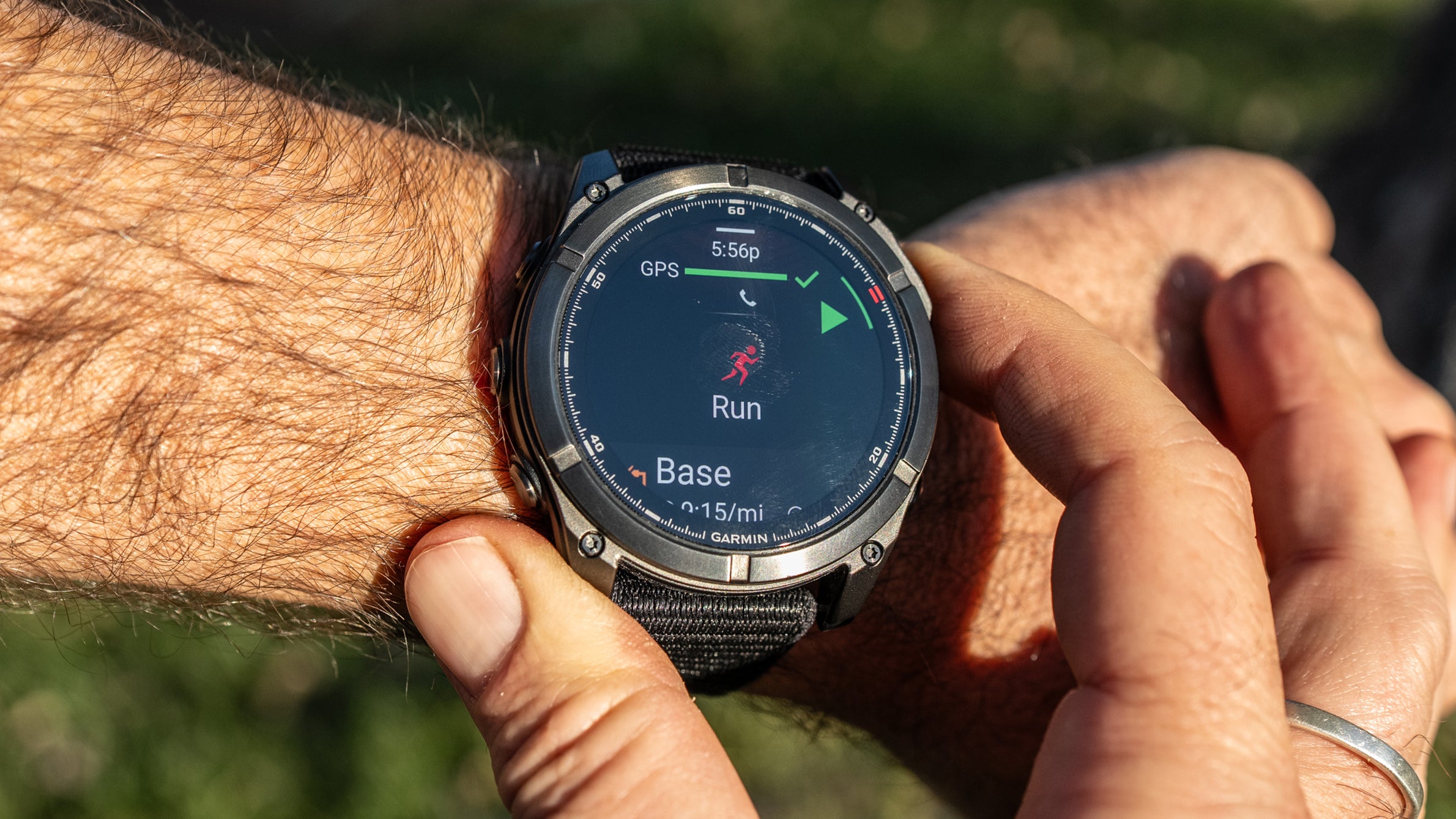
(Photo: Jakob Schiller)
Imagine running, hiking, and cycling 10,000 miles—like starting at the top of the Pan-American Highway in Prudhoe Bay, Alaska, and making it all the way to Ecuador. That’s how many miles our diverse testers covered over two years of testing to find the best sports watches.
October 2025 update: We added three new watches, including a new Best Overall pick in the Garmin fenix 8 Pro.
Best Sports Watches: At a Glance
- Best Overall: Garmin fenix 8 Pro AMOLED ($1,299)
- Best for Workouts: Garmin Enduro 3 ($900)
- Best Value for Price: Amazfit T-Rex 3 Pro ($399)
- Best for Runners: Coros Pace Pro ($349)
- Best for Weekend Warriors: Apple Watch Ultra 3 ($799)
- Best for Small Wrists: Suunto Race S Titanium Courtney ($469)
- Best Budget Sports Watch: Garmin Forerunner 165 Music ($300)
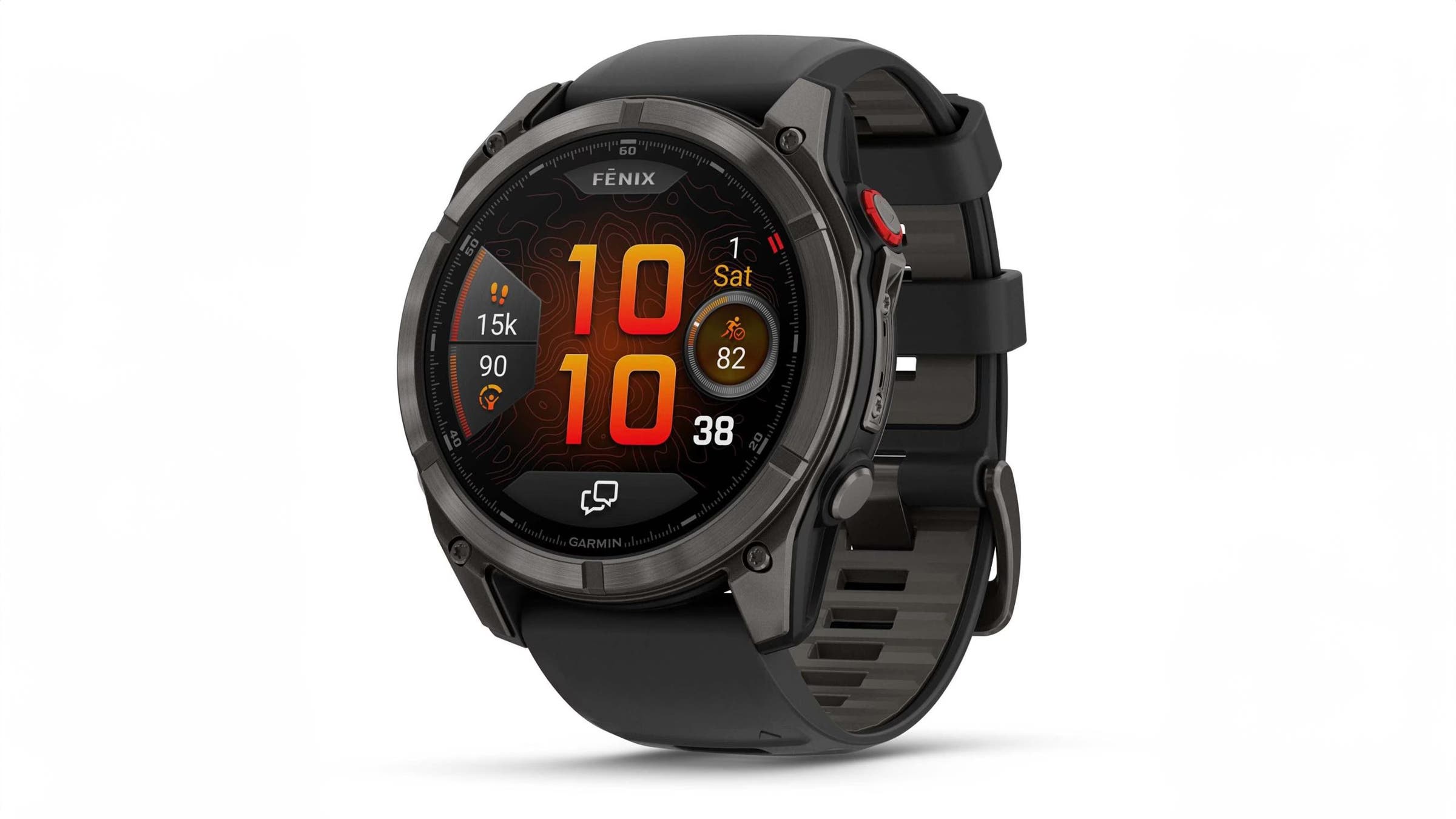
Best Sports Watch Overall
Garmin fenix 8 Pro AMOLED
Weight: 3.1 oz with strap
Face Diameter: 51 mm
Pros and Cons
+ Off-grid satellite connectivity
+ Strong battery life
+ Beautiful screen
– Pricey
– Requires a Garmin subscription for satellite connectivity
In early fall 2025, Google, Garmin, and Apple all announced new smart watches with satellite connectivity, allowing users to send messages and trigger an SOS when out of cell phone coverage. While each watch has its strengths and weaknesses, one of the most important differences among the three is that the Garmin’ fenix 8 Pro has a significantly longer battery life, making it a more reliable backcountry tool. The new off-grid connectivity, combined with Garmin’s stellar battery life, tracking accuracy, and robust feature set, makes the fenix 8 Pro a must-have for those who love to adventure far and fast, and quickly catapulted the watch into our Best Sports Watch Overall category.
According to Garmin, the fenix 8 Pro gets up to 123 hours of GPS and up to 56 hours of satellite use, giving it plenty of juice to signal for help or send satellite messages even after several days off the grid. We can see runners and fast-packers benefitting the most from the fenix 8 Pro, but we suspect backcountry skiers, hunters, and regular backpackers will instead choose to haul along a Garmin inReach, which has an even better battery life. The fenix 8 Pro’s satellite features work in the continental U.S. and most of Canada and Europe, but anyone in Alaska or Hawaii or on other continents will need a traditional inReach.
During our testing, the fenix 8 Pro’s battery life was so good we never worried day-to-day about it dying. One charge easily got us through weeks of GPS-enabled workouts and normal everyday use with time checks and notifications, as well as lots of testing using the satellite messaging feature.
Satellite messages didn’t transfer as fast as regular messages, but with a clear view of the sky they went through in just a few seconds. We also loved that Garmin allows users to override LTE connection when cell service is weak so that you can go straight to the satellite connectivity (not being able to override an inadequate signal is a serious drawback of the Apple Watch Ultra).
Like all of Garmin’s top-shelf watches, the fenix 8 Pro can track almost any workout you can think of, connects to the GPS quickly and reliably, stores plenty of music, features an intuitive menu, and provides easily customizable workout screens. The AMOLED screen was easy to read in bright sunlight, and Garmin offers a number of watch faces so you can choose the information you wish to see at a glance.
Users will need a Garmin subscription (starting at $7.99/month) to send messages via satellite or trigger an SOS. That fee also gets you LTE connectivity so you can send texts and make voice calls from the watch without having to carry your phone (more on that in our full Garmin fenix 8 Pro review).
Because of the niche features and the whopping $1,300 price tag, the fenix 8 Pro is not going to be a best-selling product. But at the moment it represents the pinnacle of sportswatch technology and offers potentially life-saving connectivity in a tiny package. Bottom line, it’s ultra convenient for those of us who want to go light and fast in remote parts of the world.
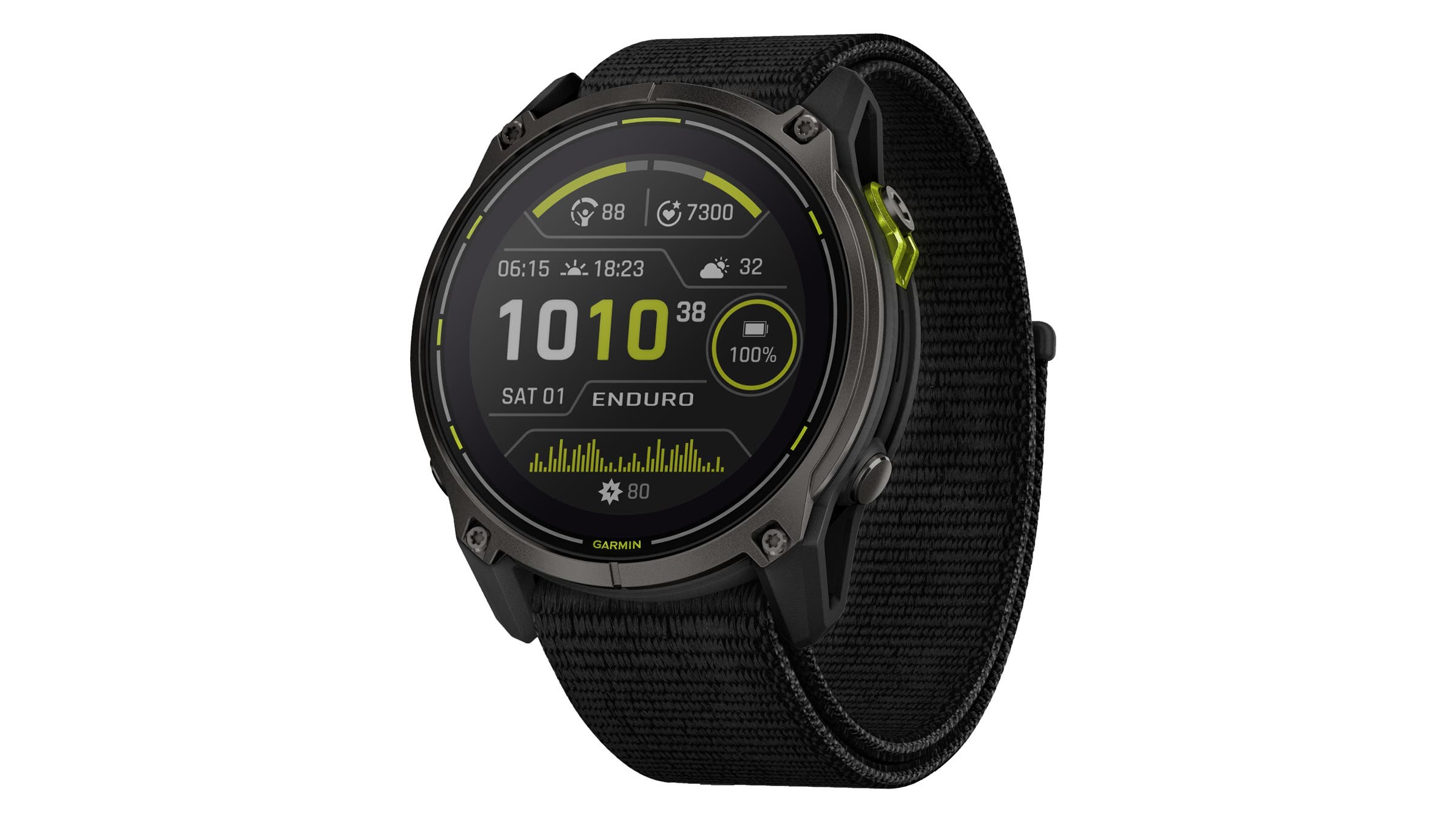
Best Sports Watch for Workouts
Garmin Enduro 3
Weight: 2.2 oz with elastic nylon strap
Face Diameter: 51 mm
Pros and Cons
+ Big and light
+ Phenomenal battery life
+ Feature rich
+ Strap is the most comfortable we’ve tried
– Pricey
The Garmin fenix Pro 8 ousted the Enduro 3 for the Best Sports Watch Overall spot in this update, but the Enduro 3 is still our favorite workout watch for a number of reasons. Controversially, maybe, we love the non-AMOLED screen. We have nothing against the bright colors offered by this technology, but the Enduro screen has a much lower power draw, giving Enduro 3 a mind-boggling battery life.
More specifically, the Enduro 3 allows for up to 36 days of smartwatch use (where you’re just using the watch for notifications and other non-workout features) and up to 120 hours of GPS use. Throw in some solar charging, and the watch will keep ticking for a reported 90 days of general smartwatch use and a staggering 320 hours (13+ days) of GPS tracking. One tester said he easily went over a month between charges (longer during the abundant summer sun) with 24/7 daily use and about an hour of activity tracking per day.
Inside the software, the Enduro 3 will track nearly every sport or exercise imaginable—as diverse as wakesurfing and rugby. It also comes with plenty of space for downloaded maps, and provides turn-by-turn directions so backcountry skiers or trail runners will never get lost. That memory also has space for downloading several hundred songs, which have helped me stay motivated on long, grueling road runs. Plus, the elastic nylon strap is the most comfortable we’ve ever used; not once did testers get a rash, and they raved that the adjustability created the perfect fit.
The Enduro 3 only weighs .9 ounces less than the fenix Pro 3, but damn if we didn’t notice that it was the lightest 51-millimeter watch we’ve ever worn. This barely-there feel made a big difference, even if just mentally, when covering a lot of miles.
All top-end Garmin watches now come with an ultra-bright, LED flashlight on the bezel. Having it instantly on hand, its brightness, and the ease of directing the beam were as helpful when climbing out of my tent to pee at night as they were when I had to navigate a dark section of trail without a headlamp.
Garmin’s software interface is not as intuitive and convenient as Apple’s—and likely never will be—but it’s way better than what we’ve seen from other competitors. Tester Jonathan Beverly found the mobile app’s daily dashboard (which tracks both fitness progress and training readiness) to be intuitive, accurate, and valuable. “Whenever I ignored its recommendations to rest, I’d pay for it on subsequent days,” he said.
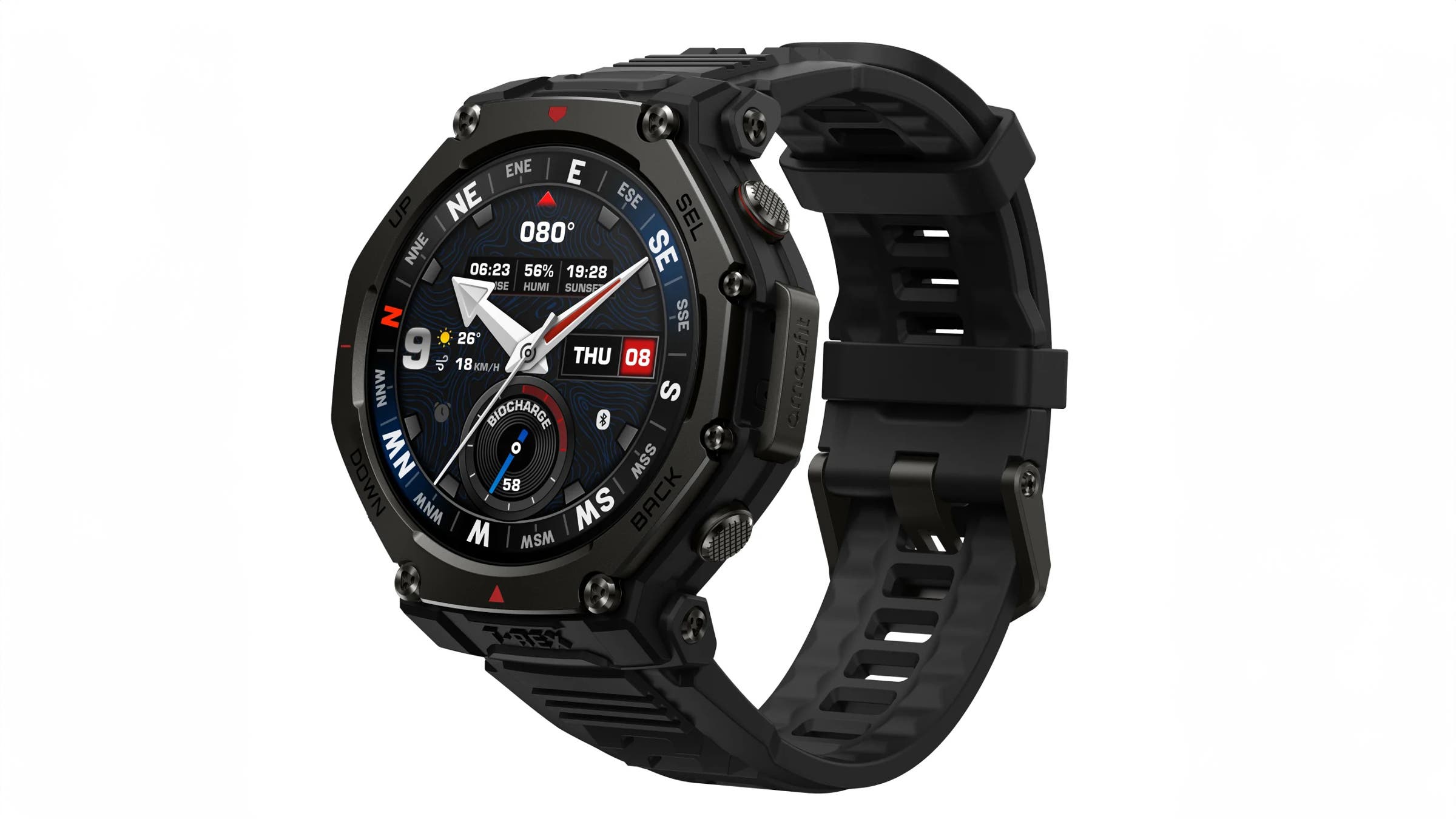
Best Value for Price
Amazfit T-Rex 3 Pro
Weight: 1.8 ounces without the strap
Face Diameter: 48 mm
Pros and Cons
+ Great battery life
+ Tough build
+ Feature-rich software
– Clunky aesthetic
A $400 watch is not exactly affordable, but the T-Rex 3 Pro still gets our value award because it packs in many of the same top-end features as more expensive, name-brand watches. A prime example is the T-Rex’s highly competitive battery life, cited as up to 25 days of normal everyday use and 38 hours of highly accurate GPS tracking.
Tester Meg Healy, who participates in up to 10 or more different activities each week, loved that there are more than 180 different workout options, from running and cycling to paragliding and equestrianism. A seasoned runner, Healy said the T-Rex 3 Pro’s running app was one of the best she’s used. It provided lots of detailed stats and feedback that helped her work on her overall fitness goals as well as her form.
Healy prioritizes accurate heart rate monitoring and found that the T-Rex 3 Pro was on par with more expensive watches from Suunto and Garmin. She also loved that the watch connected to GPS almost immediately as long as she had a clear view of the sky.
The 48mm watch face is more proportional for larger wrists. However, Healy, who’s just over five feet tall, said that the watch never got in her way during workouts and wasn’t a pain to wear to bed. Similar to a top-end Garmin watch, the T-Rex 3 Pro comes with an LED flashlight on the bezel of the watch that’s way brighter than a watch with a flashlight screen.
The watch body is made from a polymer, but the bezel is titanium and the face is sapphire glass, so the T-Rex 3 Pro will take a beating for years and be no worse for the wear. One ding: while our team doesn’t pay much attention to watch aesthetics, they felt the octagonal stop sign-like design of the T-Rex 3 Pro felt clunky compared to the rounded designs of other top-shelf watches.
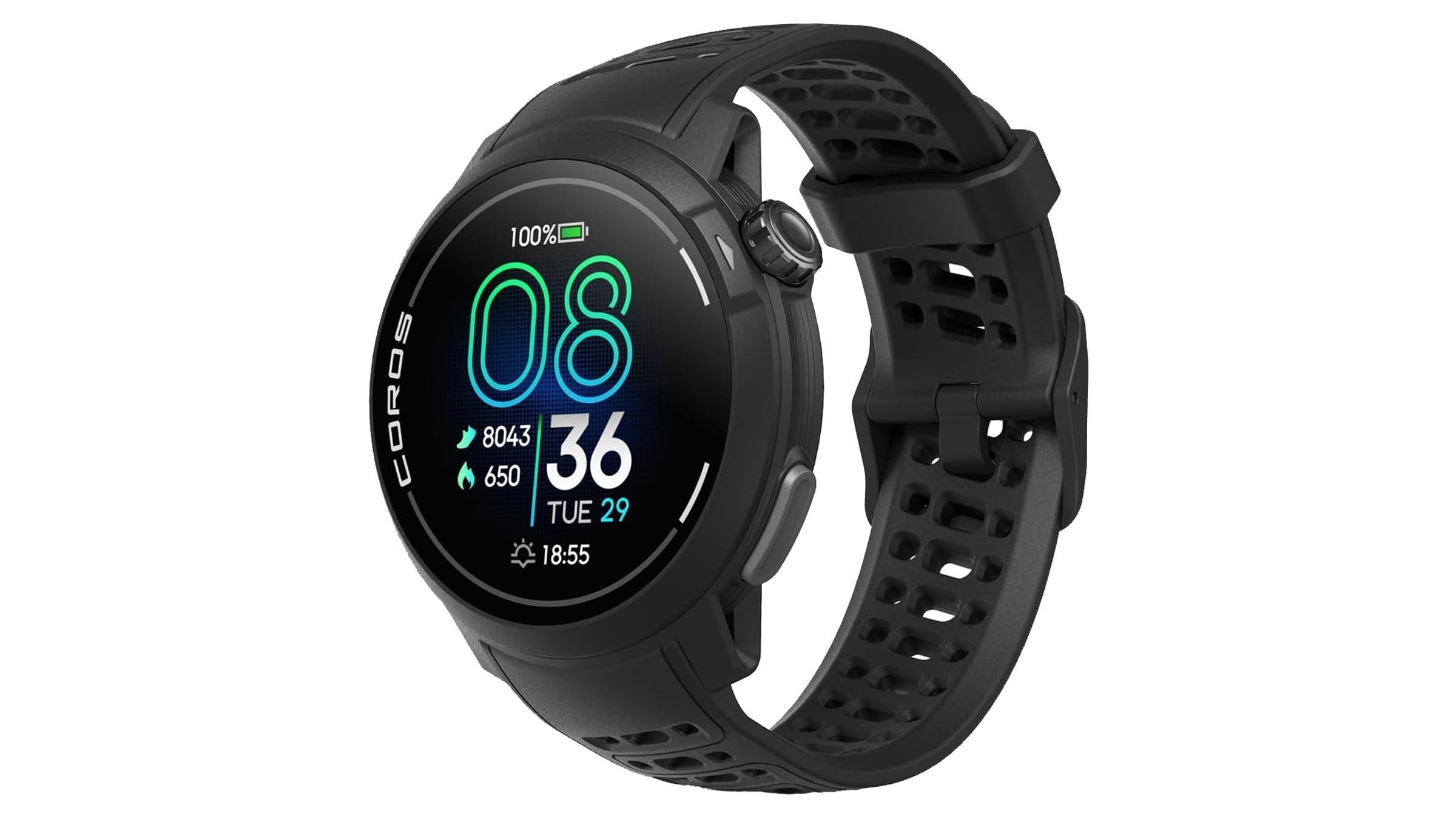
Best Watch for Runners
Coros Pace Pro
Weight: 1.7 oz with silicone band, 1.3 oz with nylon band
Face Diameter: 33 mm
Pros and Cons
+ Small but mighty
+ The screen is beautiful
+ Fairly priced
+ Ultra-quick GPS location
– Wake time isn’t immediate with arm rise
Back in college, Jesse Armijo ran the USA Olympic Marathon Trials. More recently he had a streak of winning the Duke City Half Marathon four times in a row. He’s currently training for the Black Canyon 100k Ultra in Arizona, and he organizes a youth running club for kids in Albuquerque, New Mexico. In other words, he’s a talented and dedicated runner and was the perfect tester for the Pace Pro, which bills itself as the smart choice for serious athletes (especially those who pound the pavement or trails).
Jesse put hundreds of running miles on the watch and found that it was an excellent training partner during every one of them. It picked up a GPS signal almost as soon as he stepped out of his house so that he could get up and go, and he liked the small 1.3-inch face that gave him all the info he needed—in a bright, beautiful AMOLED display— without looking ostentatious (he’s a humble guy).
In high-quality GPS mode, the watch lasts up to 38 hours, which Jesse said was more than plenty, even for an athlete of his caliber who’s often out training 10 or 20 hours per week. He found the software reasonably easy to navigate and liked built-in features like the effort-pace screen. This feature allowed him to see an adjusted pace that factored in hills and compared how hard he was working to his historical performances with similar conditions and terrain.
Jesse is a new dad, so affordability is important, and at just half the price of the Enduro 3, the Pace Pro is something he’s happy to invest in. Our only niggle: Jesse wished the watch lit up its screen more quickly when he raised his wrist.
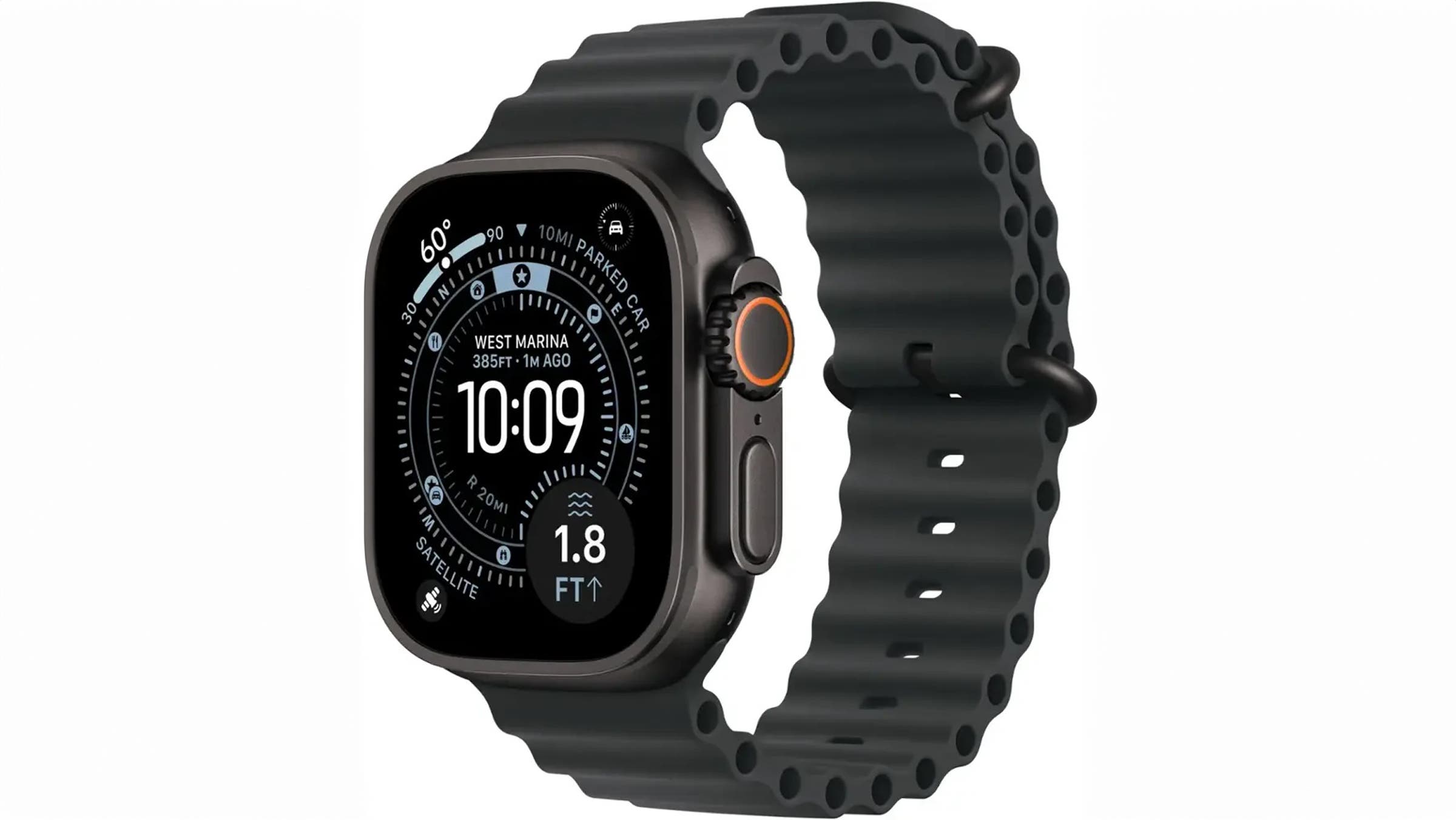
Best for Weekend Warriors
Apple Watch Ultra 3
Weight: 2.1 ounces without the strap
Face Diameter: 49mm
Pros and Cons
+ Satellite connectivity
+ Great workout software
+ Seemless iPhone integration
– Two-day battery life
Every year we hope Apple will announce that the new Ultra has an interface that allows it to challenge Garmin’s superior battery life. To our dismay, Apple instead continues to prioritize battery-eating everyday functionality. After three versions, we get the message and are making peace with it, because the Ultras, including the new Ultra 3, combine the best weekday watch functionality with tools that help you play in the backcountry (even if not for as long as we’d like).
This year, the Ultra 3 takes a big step forward in terms of outdoor usefulness thanks to its new satellite connectivity features. Anyone who buys an Ultra 3 gets two years of SOS alert capability that allows you to contact emergency services if you’re lost or injured and without cell coverage. If you add a cell plan to the watch ($5 to $15/month depending on your carrier) you also get two-way satellite messaging and Find My via satellite.
In my Ultra 3 Apple Watch testing, the satellite messaging worked seamlessly. I found a spot where I had no cell bars and a satellite icon immediately popped up and told me where to point the watch. In 30 seconds I was connected. Text messages to my wife went through to her iPhone in under 5-10 seconds, and her return messages also came through quickly. Satellite location updates via Find My have to be done manually and only work every 15 minutes, but that’s plenty to keep friends and family up to date. The only niggle is that, unlike the Garmin Pro 8, the Ultra 3 will not override a poor cell connection. You have to be truly off-grid for the watch to give you a satellite option (something we hope Apple fixes down the road).
The Ultra 3’s battery life improves to 42 hours of “normal” use compared to 36 for the Ultra 2. Apple’s definition of normal includes a workout with music, sleep tracking, constant time checks and notifications, and several hours of cellular connectivity. If you want to use the watch in Race mode—which provides the most accurate heart rate and GPS readings—Apple says the battery will last up to 20 hours if you turn on Low Power Mode, which saves battery life by limiting non-vital notifications and disabling other battery-sucking features.
When I tested it, I got nearly two full days of use, which included a GPS workout, some satellite texting with my wife, tons of notifications, and one night of sleep tracking. I was fairly confident the watch would make it until bedtime on the second day, but when the power dipped under 20 percent, I got worried. Ever since, I’ve plugged it in every night just to be sure I have enough battery to do whatever I want each day.
The Ultra 3, along with any other Apple watch capable of running the new watchOS 26 operating system, now gets Workout Buddy. This software reads your workout data and fitness history, then sends details through your phone to your AirPods, feeding you stats and motivation via a dynamic voice before, during, and after your workout. I’ve appreciated the added info and motivational help, but the feature can be turned off if you hate having a digital assistant in your ear.
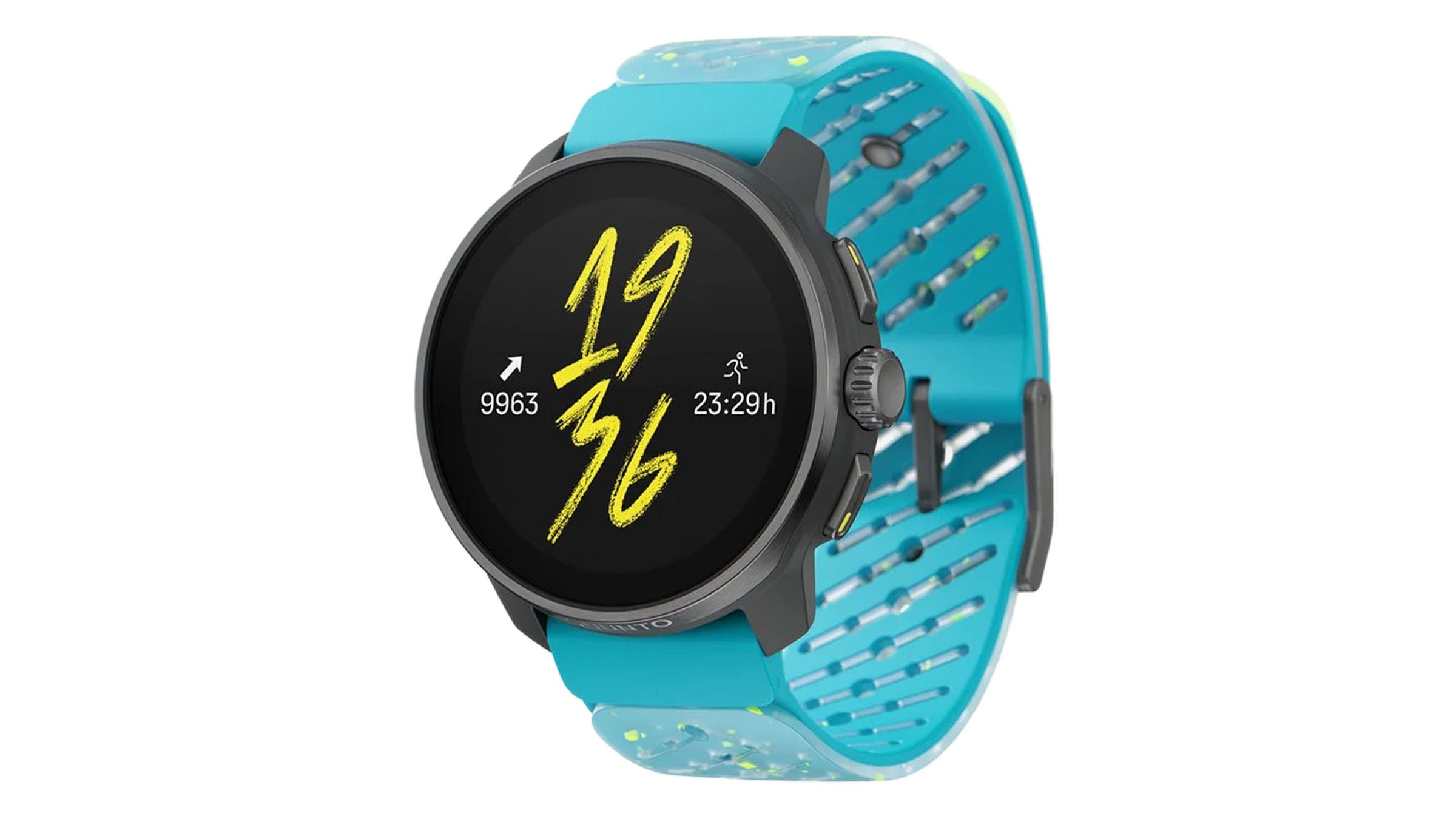
Best for Small Wrists
Suunto Race S Titanium Courtney
Weight: 1.87 oz with silicone band
Face Diameter: 33.5 mm
Pros and Cons
+ Versatile functionality
+ Tough as nails
+ Perfect for small wrists
– Heart rate takes time to settle in
We’ll be honest: Wearing a pro-model watch from Courtney Dauwalter is its own form of motivation. Just like wearing a pair of Jordans and being inspired by the GOAT himself, wearing Dauwalter’s watch always gave us a little extra motivation, channeling the strength that she used to become the first person, man or woman, to win the Western States 100, Hardrock 100, and the Ultra-Trail du Mont-Blanc trail running races all in the same year.
Meg Healy was the principal tester, and as an ultra-fit woman who’s just about five-feet tall, she said the 45 millimeter form factor was perfect for her smaller wrists but never once lacked info thanks to the 1.32-inch screen that broadcast all the info she needed, no matter the workout. Healy, who loves to pack in multiple sports every day, said she also appreciated the wide variety of activity trackers built into the software that allowed her to keep track of everything from running to martial arts to horseback riding.
Healy’s favorite part, however, was that the watch restarted her workout when she resumed after a pause, even if she didn’t remember to manually do it herself. “This saved me from not tracking large chunks of many bike rides, hikes, and runs after I’d stopped for traffic or to pick up after the dog,” she said. The battery on the Race S is respectable, lasting up to 30 hours when talking to multiple satellites. You can get a less expensive steel Race S, but we loved the feathery weight of the nearly indestructible titanium.
One potential ding: Healy noticed that the heart rate monitor wasn’t accurate at times and had trouble settling in, especially at the beginning of a workout. I didn’t put as many miles in with the Race S as Healy, but had much better luck and found the heart rate to be as accurate as those of other watches.
See our extended review of the full-size Suunto Race.
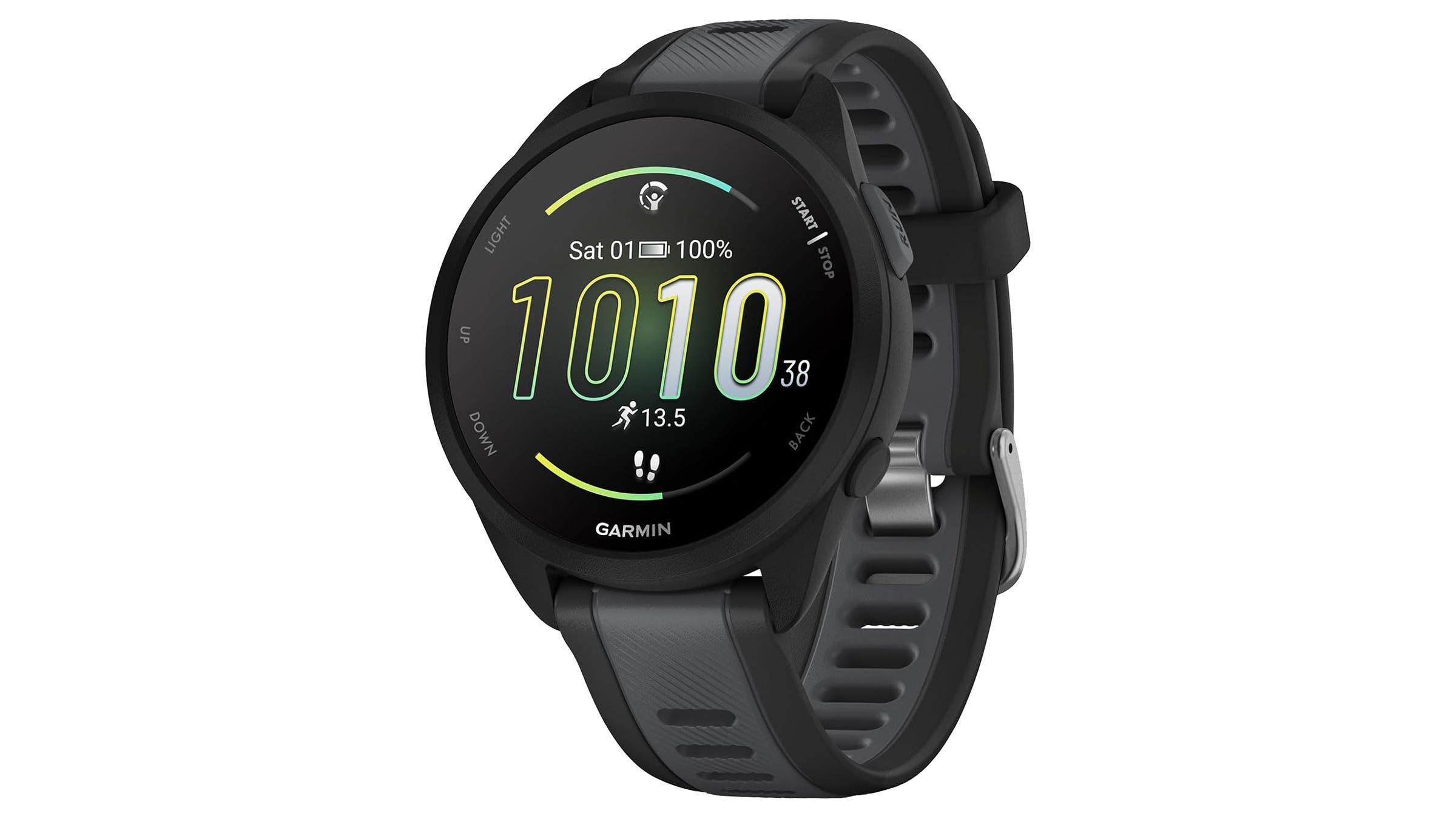
Best Budget Sports Watch
Garmin Forerunner 165 Music
Weight: 1.4 oz with the silicone band
Face Diameter: 30.4 mm
Pros and Cons
+ Feature-rich for the price
+ Large music storage capacity
+ Bright, easy-to-read screen
+ Small and light
– Battery life limited
For those of us who need a playlist to keep ourselves going when things stretch past 30 minutes, and can attest that Run the Jewels and Avicii sound great at the 45-minute mark, the Forerunner 165 Music stands out as a top training companion. Lower on the price spectrum at $300, it still comes with 4GB of music storage so we can jam for an entire workout. For that price you also get a bright AMOLED screen, accurate GPS and multi-band connection, great phone connectivity, and a comfy strap that didn’t chafe.
Meg Healy used the watch for multiple sports every day, putting in well over 1,000 miles. For her, the running metrics and coaching suggestions that Garmin provided were especially useful. Information about vertical ratio, stride length, and ground contact time helped her monitor her running form, and as a busybody she liked that the watch was not shy about recommending recovery days. “This watch is like having an opinionated but indulgent nanny who thinks you are very talented and dedicated but always working too hard. Honestly, it feels kind of nice to have that support and feedback as an adult.”
Garmin says the watch should give users 19 hours of GPS use, and Healy said she was able to get several days of use at a time before charging. But on one multi-day backpacking trip, she said the watch died, leaving her without metrics, and firming up her opinion that the watch is designed for everyday runners and cyclists and not multi-day adventurers. She also wished the activity menu included recreational sports like soccer.
How to Choose a Sports Watch
When buying a sports watch you need to decide who you really are. That sounds like some kind of spiritual question you’d ponder at a retreat, but it’s absolutely the best way to sort out what you need. Can you admit to yourself that you’re a weekend warrior because you have a job and family? Or are you totally in and going to the top as an athlete? Maybe you disappear into the backcountry for a week whenever you get the chance.
It’s necessary to categorize yourself because this will help you pick the watch that meets your goals. If your workouts are squeezed into lunch-hour work breaks, you don’t need a watch that lasts for weeks on end without charging. If you’re dedicated to really improving in your chosen sport, a higher-end watch with complex training options can be a real aid in achieving your goal. If you dabble in a variety of sports, you’ll need a watch with a robust workout menu. And if you’re an adventurer who regularly returns from trips with torn apparel and broken equipment, you need to prioritize a bullet-proof build.
Next, make sure you play with the watch you think you want—at a local retailer, if possible, or borrow one from a friend—before making a purchase. Spend time pressing buttons, and see how much effort it takes to find features and customize the watch to your preferences. All the top-end sports watches have menus that are fairly well organized, but each one is different. Little tweaks in how a watch allows you to access a workout or track data can be big motivators—or frustrations—when you’re using the thing all day every day. Note: The menus used across a specific watch brand’s line tend to be similar, so even if you don’t find the exact model you want at your local retailer, you can still get a sense of how a brand organizes its software by playing with a different watch.
How We Test
- Number of Testers: 11
- Number of Products Tested: 25
- Number of Miles: ~10,000
Over the years we’ve discovered that the best sports watch testers are adventurers who are absolutely obsessed with being outside, but come at their chosen sport without much of an ego. They love sport for sport and aren’t trying to prove anything. This balance is important because mild-mannered testers are great at digging into the features of a watch and providing in-depth feedback, but also know how to keep an everyday user in mind. There’s no mansplaining, or sportsplaining, in our tester group.
In terms of breadth, the watches we tested for this round traveled the country and saw the tops of peaks, spent hot days in the desert, and were with us during the day as our testers did everything from training troops and teaching kids to counting fish and coaching sports.
Meet Our Lead Testers
Category manager Jakob Schiller was a gear editor at Outside and is now a columnist. The father of four kids and two dogs, he’s a bit pinned down but still manages to run, ski, or bike every day and loves a good weekend-long adventure in the woods chasing elk, peak tops, or fresh turns.
One of the routes Jakob used when testing sports watches:
Jesse Armijo is a PE coach and also founded the Albuquerque, New Mexico-based Dukes Track Club, an all-ages organization that coaches kids and organizes a variety of races. He’s the most unassuming runner you’ll ever meet and is more than happy to sit in the group but can put everyone in the ground if he turns on the burners.
Meghan Healy does data management for the publishing industry and is also one of New Mexico’s most high-energy athletes. She runs races, is passionate about martial arts, rides horses, cycles around town with her kids, helps coach soccer, and is the true definition of someone who benefits from a trusted, function-rich sports watch.